ISSN ONLINE(2278-8875) PRINT (2320-3765)
ISSN ONLINE(2278-8875) PRINT (2320-3765)
Mahdi Mozaffari Legha1, Milad Askari Hashemabadi2, Vajihe Sharifi3, Hassan Javaheri1 Mohammad Mozaffari Legha4
|
| Related article at Pubmed, Scholar Google |
Visit for more related articles at International Journal of Advanced Research in Electrical, Electronics and Instrumentation Engineering
Increasing application of DG on distribution networks is the direct impact of development of technology and the energy disasters that the world is encountering. To obtain these goals the resources capacity and the installation place are of a crucial importance. Line loss reduction is one of the major benefits of DG, amongst many others, when incorporated in the power distribution system. The quantum of the line loss reduction should be exactly known to assess the effectiveness of the distributed generation. In this paper, a new method is proposed to find the optimal and simultaneous place and capacity of these DG units to reduce losses, improve voltage profile too the total loss of a practical distribution system is calculated with and without DG placement and an index, quantifying the total line loss reduction is proposed. To demonstrate the validity of the proposed algorithm, computer simulations are carried out on actual power network of Kerman Province, Iran and the simulation results are presented and discussed.
Keywords |
| Distribution systems, Loss reduction index, DG placement, Imperialist Competitive Algorithm |
INTRODUCTION |
| The effect of DG on operating characteristics of the system such as electric losses, voltage profile, stability, and reliability needs to be appropriately assessed. The problem of DG allocation and sizing is importance crucial task. Installing DG units at no optimal places may result in an increase in system losses, costs, and therefore, having an undesired effect on the system. There may be many locations that do not have overload or voltage problems, where the DG can be located and provide the necessary control [5]. As a result, using an optimization method capable of indicating the best solution for a given distribution network can be very useful for system planning engineers. Selecting the best places for installing DG units and their preferable sizes in large distribution systems is an elaborate optimization problem. Therefore it is important to find optimal location and sizes of DGs in the system to achieve the above mentioned objectives. Distributed Generation (DG) may play an increasingly important role in the electric power system organization and market. Unlike traditional generation, the aim of distributed generation is to generate part of required electrical energy on small scale closer to the places of consumption and interchanges the electrical power with the network. This paper presents analysis of Imperialist Competitive Algorithm (ICA) based system power loss minimization approach and system energy loss minimization approach also the total loss of a practical distribution system is calculated with and without DG placement and an index, quantifying the total line loss reduction for optimal sizing and placement of DG in electrical power systems. The methods are presented to find optimal size and bus location for placing DG using power loss and energy loss minimization in a networked system based on bus admittance, generation information and load distribution of the system. The proposed methods are tested by simulations actual power network of Kerman Province, Iran of 3-DG, 5-DG and 8-DG. |
OBJECTIVE FUNCTION |
| The objective of DG placement in the distribution system is to minimize the annual cost of the system, subjected to certain operating constraints and load pattern. For simplicity, the operation and maintenance cost of the DG placed in the distribution system is not taken into consideration. The three-phase system is considered as balanced and loads are assumed as time invariant. Mathematically, the objective function of the problem is described as: |
| Min f= W1×floss r + W2×fLRI(r) |
| The voltage magnitude at each bus must be maintained within its limits and is expressed as: |
| Where ̢̉̉Vỉ̢̉ is the voltage magnitude of bus i, Vmin and Vmax are bus minimum and maximum voltage limits, respectively. |
FORMULATION |
| The power flows are computed by the following set of simplified recursive equations derived from the single-line diagram depicted in Figure. 1. |
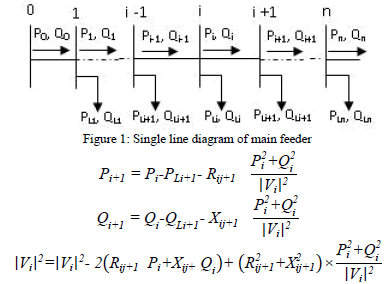 |
| The power loss of the line section connecting buses i and i+1 may be computed as |
 |
| Evolutionary algorithms are usually designed to maximize or minimize the objective function, which is a measure of the quality of each candidate solution [11]. After control variables are coded, the objective function will be evaluated. These values are the measures of quality, which is used to compare different solutions. The better solution joins the new population and the worse one is neglected. Here Total Power Loss in the Distributed Generation is used in formulation of the objective function. Tray said objective function takes the following from: |
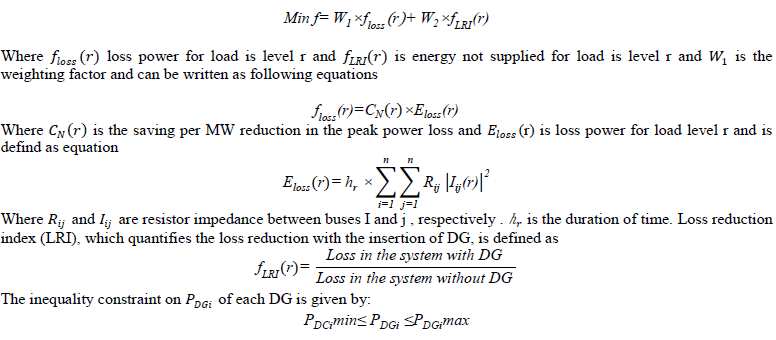 |
IMPERIALIST COMPETITIVE ALGORITHM (ICA) |
| ICA mimics the social–political process of imperialism and imperialistic competition. ICA starts with an initial population of individuals, each called a country. Some of the best countries are selected as imperialists and the rest form colonies which are then divided among imperialists based on imperialistsâÃâ¬ÃŸ power. After forming the initial empires, competition begins and colonies move towards the irrelevant imperialists. During competition, weak empires collapse and powerful ones take possession of more colonies. At the end, there exists only one empire while the position of imperialist and its colonies are the same [15]. The process ICA is depicted in Figure 2-4 and flow chart of proposed ICA is depicted in Figure 5. The flow chart of proposed method is depicted in Figure 6. |
POWER FLOW ANALYSIS METHOD |
| The Backward Sweep calculates the current injected into each branch as a function of the end node voltages. It performs a current summation while updating voltages. Bus voltages at the end nodes are initialized for the first iteration. Starting at the end buses, each branch is traversed toward the source bus updating the voltage and calculating the current injected into each bus. These calculated currents are stored and used in the subsequent Forward Sweep calculations. The calculated source voltage is used for mismatch calculation as the termination criteria by comparing it to the specified source voltage. The Forward Sweep calculates node voltages as a function of the currents injected into each bus. The Forward Sweep is a voltage drop calculation with the constraint that the source voltage used is the specified nominal voltage at the beginning of each forward sweep. The voltage is calculated at each bus, beginning at the source bus and traversing out to the end buses using the currents calculated in previous the Backward Sweep [6]. |
LOSS REDUCTION ANALYSIS |
| The total loss of the distribution system without DG is given by |
 |
| Where Ii is the current flowing through ith section, r is the resistance of line in ohms per unit length, Li is the length of ith section, Pci is the core loss of ith transformer, PLv i is the Losses on the low voltage side of the ith transformer and N is the number of busses in the system [17.23]. The total loss of the distribution system with DG is now |
 |
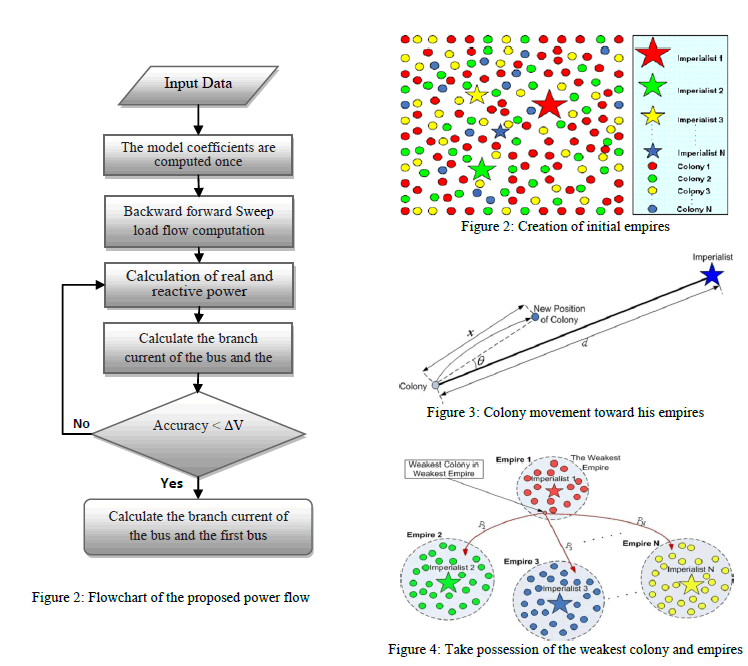 |
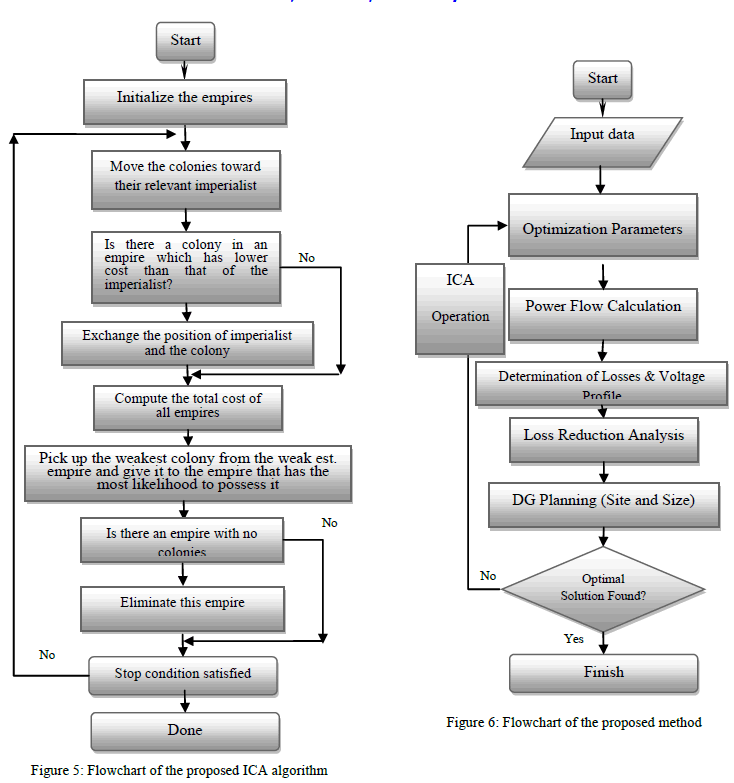 |
TESTS AND RESULTS |
| To study the proposed method, actual power network of Kosar feeder of Kerman Province, Iran is simulated in MATLAB. Figure 7 illustrates the single-line diagram of this network. The base values of the system are taken as 20kV and 20MVA. The system consists of 20 distribution transformers with various ratings. The details of the distribution transformers are given in table 1. The details of the distribution conductors are given in Table 2. The total connected load on the system is 2550 KVA and the peak demand for the year is 2120 KVA at a PF of 0.8 lag. |
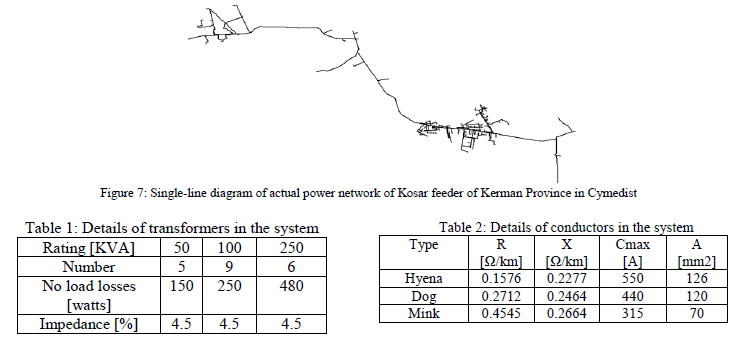 |
| Initially, a load flow was run for the case study without installation of DG. Table 3 depicts the locations and capacity of DG using Imperialist Competitive Algorithm. As it is clear, all the obtained values confines with all the considered constraints. The obtained penetration lever is 0.27, which is less than the assumed allowable value. |
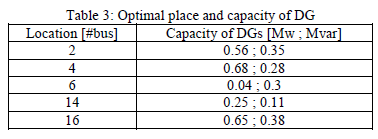 |
| In addition the total network loss, which was 10.05MW before installing DG, has diminished to the 4.55MW which shows 45.81% decrease. The detailed pu voltages profile and Percentage of loss of all the nodes of the system before and after DG placement with 5 DG units are shown in the Figure 8 and Figure 9. |
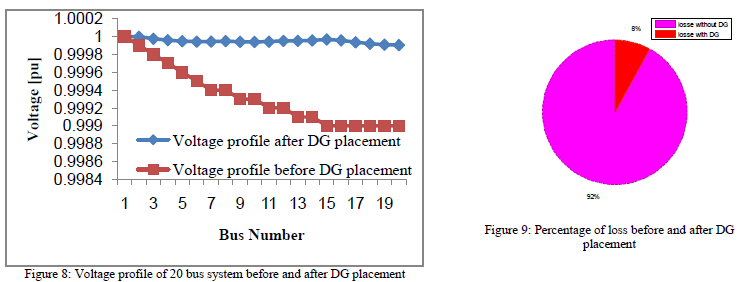 |
| The simulation results are given in Table 4. These results reveal that the inclusions of DG reduce the line losses as expected. It can be shown from the graphs that, LRI decreases marginally, since the core losses of the transformers and the LV side losses remain constant being independent of the presence of DG. It can also be seen that with the increase in the active power capacity of DG, LRI, decrease also with the increase in the number of DG, LRI, due to increasing of active power ,decrease. |
 |
CONCLUSION |
| In the present paper, a new population based Imperialist Competitive Algorithm (ICA) has been proposed to solve DG placement problem and quantifying the total line loss reduction in distribution system. Simulations are carried on actual power network of Kerman Province, Iran. The simulation results show that the inclusion of DG, marginally reduce the losses in a distribution system. This is because; the line losses form only a minor part of the distribution system losses and the DG can reduce only the line losses. The other losses viz. the transformer losses and the LV side distribution losses remain unaltered. Hence this fact should be considered before installing a DG into a system. The results obtained by the proposed method outperform the other methods in terms of quality of the solution and computation efficiency. |
References |
|